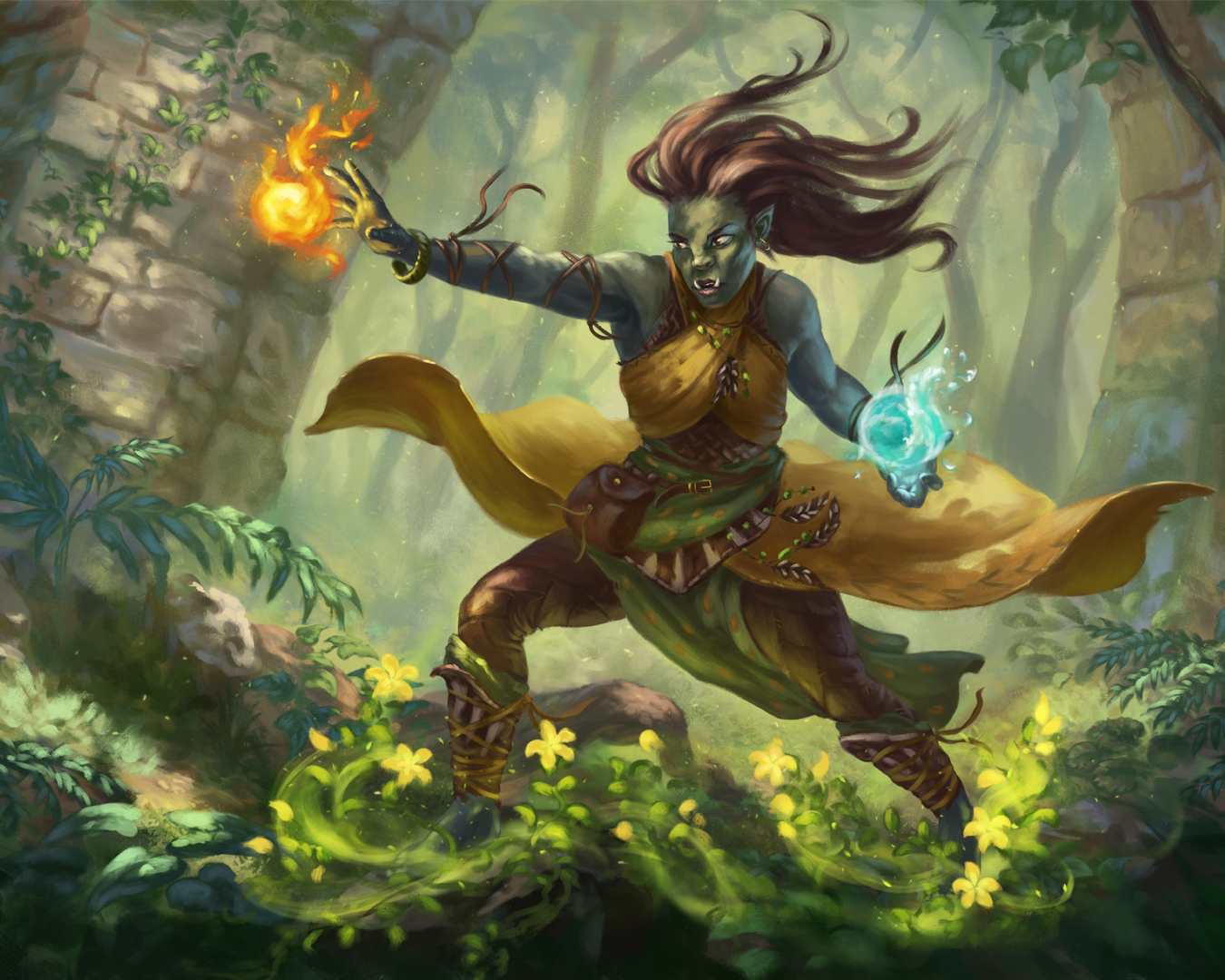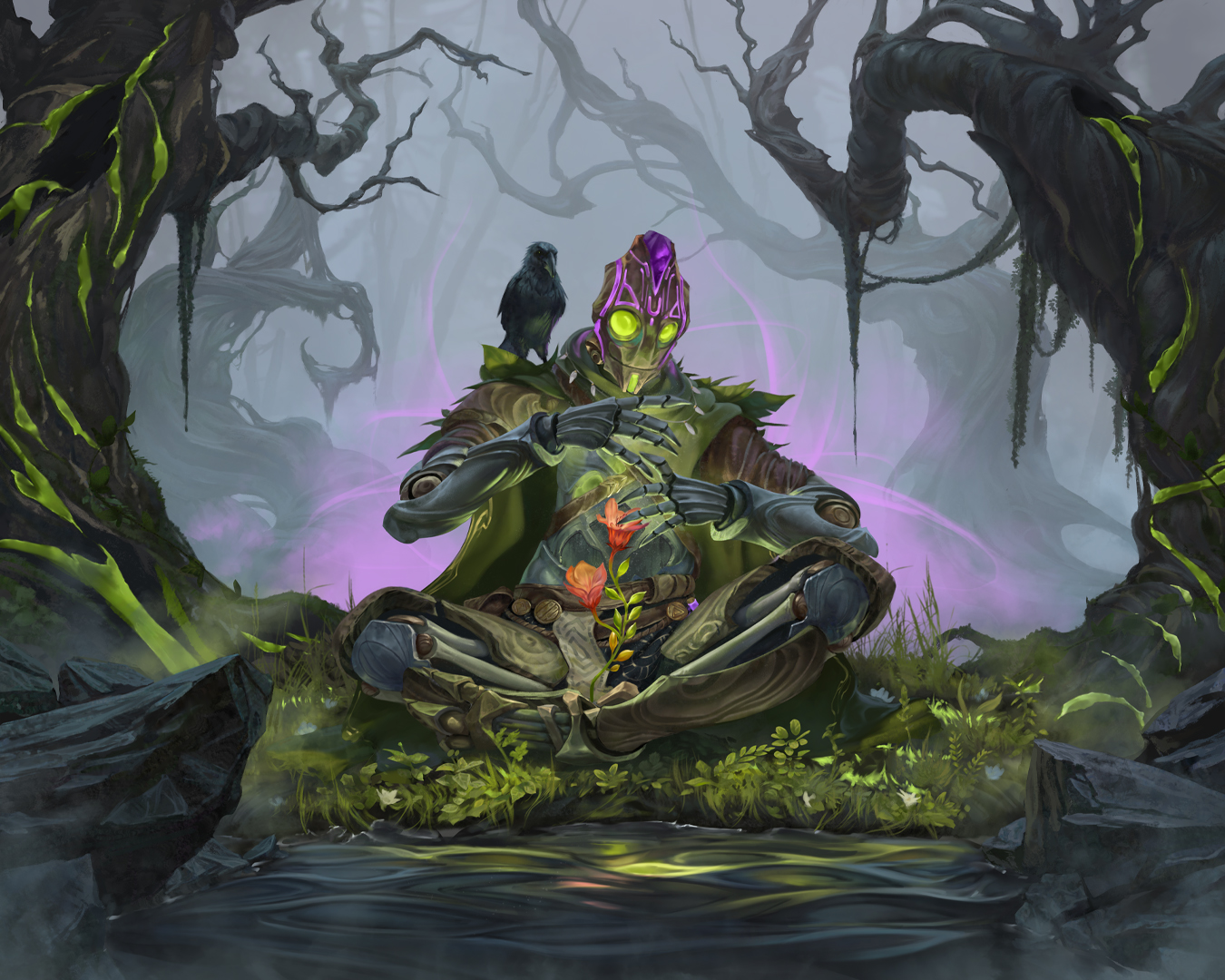druid


10


druid
Class Features
Evolution: Spend 3 Hope to transform into a beastform without marking a Stress. When you do, choose one trait to raise by +1 until you drop out of that Beastform.
Beastform: Mark a Stress to magically transform into a creature of your tier or lower from the Beastform list. You can drop out of this form at any time. While transformed, you can't use weapons or cast spells from domain cards, but you can still use other features and abiliities you have access to. Spells you cast before you transform stay active and last for their normal duration, and you can talk and communicate as normal. Additionally, you gain the Beastform's features, add their Evasion bonus to your Evasion, and use the trait specified in their statistics for your attack. While you're in a Beastform, your armor becomes part of your body and you mark Armor Slots as usual; when you drop out of a Beastform, those marked Armor Slots remained marked. If you mark your last Hit Point, you automatically drop out of this form.
Wildtouch: You can perform harmless, subtle effects that involve nature - such as causing a flower to rapidly grow, summoning a slight gust of wind, or starting a campfire - at will.
Becoming a druid is more than an occupation; it's a calling for those who wish to learn from and protect the magic of the wilderness. While one might underestimate a gentle druid who practices the often-quiet work of cultivating flora, druids who channel the untamed forces of nature are terrifying to behold. Druids cultivate their abilities in small groups, often connected by a specific ethos or locale, but some choose to work alone. Through years of study and dedication, druids can learn to transform into beasts and shape nature itself.
Starting Evasion: 10
Starting Hit Points: 6
Class Items: A small bag of rocks and bones or a strange pendant found in the dirt.
Background Questions
Answer any of the following background questions. You can also create your own questions.
- Why was the community you grew up in so reliant on nature and its creatures?
- Who was the first wild animal you bonded with? Why did your bond end?
- Who has been trying to hunt you down? What do they want from you?
Connections
Ask your fellow players one of the following questions for their character to answer, or create your own questions.
- What did you confide in me that makes me leap into danger for you every time?
- What animal do I say you remind me of?
- What affectionate nickname have you given me?
Beastform Options
When you use your "Beastform" feature, choose a creature category of your tier or lower. At the GM's discretion, you can describe yourself transforming into any animal that reasonably fits into that category.
Beastform categories are divided by tier. Each entry includes the following details:
- Creature Category: Each category's name describes the common role or behavior of creatures in that category (such as Agile Scout). This name is followed by a few examples of animals that fit in that category (in this example, fox, mouse, and weasel).
- Character Trait: While transformed, you gain a bonus to the listed trait. For example, while transformed into an Agile Scout, you gain a +1 bonus to your Agility. When this form drops, you lose this bonus.
- Attack Roles: When you make an attack while transformed, you use the creature's listed range, trait, and damage dice, but you use your Proficiency. For example, as an Agile Scout, you can attack a target within Melee range using your Agility. On a success, you deal d4 physical damage using your Proficiency
- Evasion: While transformed, you add the creature's Evasion bonus to your normal Evasion. For example, if your Evasion is usually 8 and your Beastform says "Evasion +2," your Evasion becomes 10 while you're in that form.
- Advantage: Your form makes you especially suited to certain actions. When you make an action or reaction roll related to one of the verbs listed for that creature category, you gain advantage on that roll. For example, an Agile Scout gains advantage on rolls made to sneak around, search for objects or creatures, and related activities.
- Features: Each form includes unique features. For example, an Agile Scout excels at silent, dexterous movement—but they're also fragile, making you more likely to drop out of Beastform.
For a full list of beastforms you can take a look at here.
Subclasses
Play the Warden of the Elements if you want to embody the natural elements of the wild.



Warden of the Elements
Foundation
SPELLCAST: INSTINCT
Elemental Incarnation: Mark a Stress to Channel one of the following elements until you take Severe damage or until your next rest:
- Fire: When an adversary within Melee range deals damage to you, they take 1d10 magic damage.
- Earth: Gain a bonus to your damage thresholds equal to your Proficiency.
- Water: When you deal damage to an adversary within Melee range, all other adversaries within Very Close range must mark a Stress.
- Air: You can hover, gainging advantage on Agility Rolls.



Warden of the Elements
Specialization
Elemental Aura: Once per rest while Channeling, you can assume an aura matching your element. The aura affects targets within Close range until your Channeling ends.
- Fire: When an adversary marks 11 or more Hit Points, they must also mark a Stress.
- Earth: Your allies gain a +1 bonus to Strength.
- Water: When an adversary deals damage to you, you can mark a Stress to move them anywhere within Very Close range of where they are.
- Air: When you or an ally takes damage from an attack beyond Melee range, reduce the damage by 1d8.



Warden of the Elements
Mastery
Elemental Dominion: You further embody your element. While Channeling, you gain the following benefit:
- Fire: You gain a +1 bonus to your Proficiency for attacks and spells that deal damage.
- Earth: When you would mark Hit Points, roll a d6 per Hit Point marked. For each result of 6, reduce the number of Hit Pointsn you mark by 1.
- Water: When an attack against you succeeds, you can mark a Stress to make the attacker temporarily Vulnerable.
- Air: You gain a +1 bonus to your Evasion and can fly.
Play the Warden of Renewal if you want to use powerful magic to heal your party.



Warden of Renewal
Foundation
SPELLCAST: INSTINCT
Clarity of Nature: Once per long rest, you can create a space of natural serenity within Close range. When you spend a few minutes resting within the space, clear Stress equal to your Instinct, distributed as you choose between you and your allies.
Regeneration: Touch a creature and spend 3 Hope. That creature clears 1d4 allies within Close range.



Warden of Renewal
Specialization
Regenerative Reach: You can target creatures within Very Close Range with your "Regeneration" feature
Warden's Protection: Once per long rest, spend 2 Hope to clear 2 Hit Pointns on 1d4 allies within Close range.



Warden of Renewal
Mastery
Defender: Your animal transformation embodies a healing guardian spirit. When you're in Beastform and an ally within Close range marks 2 or more Hit Pointsn, you can mark a Stress to reduce the number of Hit Points they mark by 1.

The materials and references within this application are limited to those included in the Daggerheart System Reference Document (SRD) and all creations are intended to be comptible with the Daggerheart TTRPG system. Users are responsible for ensuring that any content they create complies with the terms of the Darrington Press Community Gaming License. If you intend to distribute content created using this application, please consult the license to ensure compliance with its terms. This application is not affiliated with, endorsed by, or sponsored by Darrington Press.